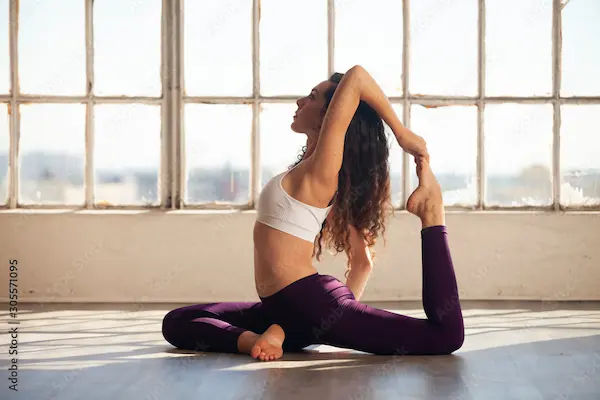Vajrasana Pose: Amazing Health Benefits and How to Do It
Discover vajrasana benefits with a safe, step-by-step guide. Learn yoga for digestion, posture, calm, and fitness—plus FAQs and trusted sources.


Introduction
Vajrasana (Thunderbolt or Diamond Pose) is a simple kneeling yoga posture commonly used for meditation, breathing exercises, and gentle stretching. Many people use it as yoga for digestion, posture, and emotional calm. This guide explains what Vajrasana is, how to perform it safely, its benefits supported by evidence, and where caution may be needed. Additionally, it offers practical tips on including Vajrasana in your daily routine and answers to frequently asked questions. Understanding how to use this pose effectively can enhance mindfulness, support gentle physical alignment, and provide a calm, restorative moment in your day.
What Is Vajrasana?
Vajrasana is a kneeling seated yoga pose.
How to sit in Vajrasana:
- Kneel on the floor, with the tops of your feet resting flat on the mat.
- Keep your knees together or hip‑width apart, depending on what feels comfortable.
- Sit back gently on your heels.
- Keep your spine tall, shoulders relaxed.
- Rest your hands on your thighs and breathe steadily.
People often use Vajrasana during meditation or breathwork because the position keeps the spine upright, encourages slow, steady breathing, and provides a stable base. Practising Vajrasana regularly can help build awareness of posture and alignment, which is valuable in both daily life and other yoga practices.
Consult a Top General Practitioner for Personalised Advice
Benefits of Vajrasana: What We Know (and What We Don’t)
There is no strong scientific evidence isolating Vajrasana alone as a treatment for specific medical concerns, such as digestion or weight loss. However, research indicates that regular yoga practice as a whole offers a range of health benefits that indirectly support the body systems involved in digestion, stress regulation, and mobility.
Potential benefits linked with consistent yoga practice:
- Supports stress relief: Mindful breathing combined with gentle movement reduces stress hormones and promotes relaxation.
- Improves flexibility and balance: Regular seated and kneeling postures gradually enhance joint mobility, especially in the hips, knees, and ankles.
- Encourages posture awareness: Sitting upright strengthens awareness of spinal alignment and can reduce discomfort from prolonged sitting or poor posture.
- Aids general fitness: Yoga complements aerobic and strength workouts by enhancing mobility, breathing control, and muscular endurance.
- Supports mindful habits: Taking a moment in Vajrasana encourages mental focus and grounding, which can influence healthier eating and lifestyle choices.
Yoga and Digestion – Can Vajrasana Help?
Vajrasana is often recommended after meals because sitting upright can feel calming. This position allows the diaphragm and abdominal muscles to remain relaxed, potentially encouraging gentle digestion.
What may help digestion:
- Upright posture encourages relaxed breathing, which may help the nervous system shift into a parasympathetic (“rest and digest”) state.
- Slow, deep breaths may reduce tension in the abdominal area and provide a moment of mindful awareness after eating.
What is not yet proven:
- Strong scientific studies linking Vajrasana alone to improved digestion are limited.
- Persistent digestive symptoms should be assessed by a healthcare professional.
Key takeaway: Vajrasana may feel soothing and encourage mindful eating habits, but it is not a replacement for medical treatment or dietary adjustments.
How To Do Vajrasana (Step‑By‑Step)
The step by step guide is:
Step 1: Setting up
- Place a yoga mat or folded blanket on the floor to cushion knees and ankles.
- Kneel with knees together or hip‑width apart.
Step 2: Sitting back
- Gently lower your hips towards your heels.
- If uncomfortable, place a yoga block or cushion between your heels for support.
Step 3: Posture alignment
- Lengthen your spine, imagining a straight line from the tailbone to the crown of the head.
- Relax your shoulders downward, away from the ears.
- Keep your chin parallel to the floor.
Step 4: Hand position
- Rest hands on thighs.
- Palms can face up or down, whichever feels most natural.
Step 5: Breathing
- Inhale through the nose for 4–6 seconds.
- Exhale through the nose for 4–6 seconds.
- Start with 30–60 seconds and gradually increase the duration as comfort allows.
Step 6: Coming out safely
- Lean forward slightly.
- Lift your hips and move legs to one side.
- Roll ankles and wiggle toes to restore circulation.
Tips for Comfort and Alignment
Tips for comfort and alignment include:
- Place a folded towel under the shins or ankles if they feel sensitive.
- Use a block or cushion between heels to decrease knee pressure.
- If numbness or tingling begins, slowly exit the pose and return later.
- Keep breathing smoothly and continuously, avoiding any strain.
- Adjust knee spacing slightly if hips feel tight, maintaining comfort over strict form.
How To Use Vajrasana in Your Fitness Routine?
It can be included as:
When to include Vajrasana:
- During warm-up or cool-down, for gentle stretching.
- After meals to encourage calm breathing and mindful relaxation.
- As a short meditation break during busy workdays.
Ideas for pairing:
- Child’s Pose: For deeper relaxation of the spine and hips.
- Cat–Cow: For gentle spinal mobility and breath synchronisation.
- Forward Fold: To lengthen the back of the body and release tension.
Yoga complements other fitness activities but does not replace cardio or strength training. Vajrasana can serve as a restorative pause within a broader routine.
Who Should Modify or Be Cautious?
Consider adjustments if you have:
- Knee, ankle, or foot injuries—use props or alternative seated positions.
- Arthritis or restricted knee mobility—sit on blocks or cushions to reduce strain.
- Circulation or nerve concerns in the lower legs—limit hold time and monitor for tingling.
- Pregnancy—avoid long holds if pressure or discomfort is present; consider side-lying alternatives.
- Generous use of props ensures that Vajrasana remains safe and comfortable.
Common Mistakes to Avoid
Common mistakes to avoid are:
Avoid slumping or arching your back
Maintain a neutral spine to prevent strain.
Avoid forcing the knees
Use props rather than pushing through pain.
Avoid holding your breath
Maintain smooth, relaxed breathing throughout the pose.
Avoid staying still through numbness
If tingling occurs, exit the pose, move your legs, and try again later.
Beginner‑Friendly Progression
It includes:
- Week 1: Practise 30–60 seconds, 1–2 times per day.
- Week 2: Increase to 1–2 minutes as comfort improves.
- Week 3+: Extend to 3–5 minutes, a few times per week.
Consistency and mindful attention are more important than duration.
Realistic Expectations
The realistic explanations include:
- Expect gradual improvements in comfort, posture awareness, and stress management.
- Yoga does not target fat loss in specific areas.
- Combine yoga with varied exercise, balanced nutrition, and adequate sleep for overall wellness.
- Mindfulness and patience enhance the benefits of regular practice.
Conclusion
Vajrasana is a simple, accessible posture that offers a stable base for mindful breathing, meditation, and gentle stretching. Practising it regularly can support relaxation, posture awareness, and overall body alignment, making it a useful addition to yoga or fitness routines. While it may feel calming after meals, it should not be treated as a medical remedy for digestive issues or weight loss. Adjust the pose using cushions or blocks for comfort, listen to your body, and incorporate it consistently for gradual improvements in mobility, mental calm, and well-being. Over time, Vajrasana can become a grounding and restorative posture that fits seamlessly into daily life.
Consult a Top General Practitioner for Personalised Advice
Consult a Top General Practitioner for Personalised Advice

Dr. Mainak Baksi
General Practitioner
13 Years • MBBS , MD (MPH)
Howrah
Mainak Baksi Clinic, Howrah
(50+ Patients)

Dr Suseela
General Physician
5 Years • MBBS
Bengaluru
Apollo Medical Center, Marathahalli, Bengaluru

Dr. Rajib Ghose
General Physician/ Internal Medicine Specialist
25 Years • MBBS
East Midnapore
VIVEKANANDA SEBA SADAN, East Midnapore

Dr. Anamika Krishnan
General Practitioner
11 Years • MBBS, DNB (Paediatrics) ,Diploma in child Health
Bengaluru
UMC (United Medical Center), Bengaluru

Dr Syed Mizra M
General Physician/ Internal Medicine Specialist
2 Years • MBBS
Bengaluru
PRESTIGE SHANTHINIKETAN - SOCIETY CLINIC, Bengaluru
Consult a Top General Practitioner for Personalised Advice

Dr. Mainak Baksi
General Practitioner
13 Years • MBBS , MD (MPH)
Howrah
Mainak Baksi Clinic, Howrah
(50+ Patients)

Dr Suseela
General Physician
5 Years • MBBS
Bengaluru
Apollo Medical Center, Marathahalli, Bengaluru

Dr. Rajib Ghose
General Physician/ Internal Medicine Specialist
25 Years • MBBS
East Midnapore
VIVEKANANDA SEBA SADAN, East Midnapore

Dr. Anamika Krishnan
General Practitioner
11 Years • MBBS, DNB (Paediatrics) ,Diploma in child Health
Bengaluru
UMC (United Medical Center), Bengaluru

Dr Syed Mizra M
General Physician/ Internal Medicine Specialist
2 Years • MBBS
Bengaluru
PRESTIGE SHANTHINIKETAN - SOCIETY CLINIC, Bengaluru
More articles from General Medical Consultation
Frequently Asked Questions
Is Vajrasana good for digestion?
It may feel soothing, helping maintain an upright posture, but there is limited clinical evidence supporting its effect on digestion alone.
How long should I hold Vajrasana?
Start with 30–60 seconds and build gradually to 3–5 minutes as comfort allows.
Is Vajrasana safe if I have knee pain?
Only if it is pain-free. Use props or choose another seated position and consult a clinician if needed.
Can Vajrasana reduce belly fat?
No single pose targets fat loss. Combine yoga with healthy habits, balanced nutrition, and overall physical activity.
Best time to practise Vajrasana
Any time that is comfortable and consistent. Many prefer short sessions after meals or as a mindful break during work or study.




